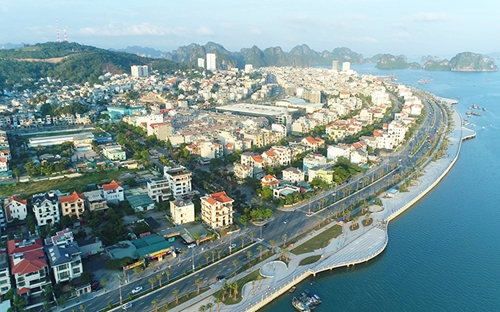The early approval of the province's urban development program to 2030 is a prerequisite to focus all investment resources and soon build Quang Ninh into a centrally-run city by 2030.
Quang Ninh has a fairly developed urban system, but there is a difference in terms of the development speed and scale of each area. Fast-growing and large-scale urban centers develop along main traffic routes, concentrated in coastal areas, associating with the development of tourist, service, industrial, and port areas.
    |
 |
|
An aerial photo of Ha Long city, Quang Ninh province (Photo: baohoabinh) |
To become a centrally run city by 2030, Quang Ninh province set strategic goals many years ago.
Nguyen Tuong Van, Chairman of the provincial People's Committee, said the province's target is to develop an urban area system towards a sustainable direction and to build and develop a green economy based on science, technology, and human resources.
One of Quang Ninh's breakthrough strategies in the process of accelerating urban planning is investing in infrastructure systems. Up to now, many important infrastructure works have been completed, contributing to the synchronous connection of transport infrastructure in the province and the region. It also helps promote the socio-economic development of the whole region.
During its development process, Quang Ninh always determines that planning must be the first and foremost step. The province has spent a lot of resources and at the same time called for strategic investors to participate in the implementation of key projects, creating a stronger driving force for socio-economic development.
Regarding the planning work, it was determined that the planning must be relevant to the socio-economic development strategy of the country, the region, and that of sectors and fields.
It was necessary to make a breakthrough based on potential and advantages of the province, ensuring modernity, synchronisation and meeting the international standards.
Since its first planning, the province has invited leading consulting firms such as McKinsey Group, BCG (the United States), Nikken Sekkei and Nippon Koie (Japan) to get involved in. These plannings have closely followed the development space of the province, assuring the connectivity to promote the strengths of each locality in the province and the Red River Delta, and the northern key economic region.
To realize the goal of developing Quang Ninh into a civilized and modern city, the province has identified three strategic breakthroughs in the urban development program to 2030. They were developing high quality human resources in association with increasing population scale and quality; speeding up the development of synchronized and modern strategic infrastructure, and promoting local cultural identities while shortening the income gap.
In addition, the province is also finalizing the medium-term public investment plan for the 2021-2025 period. Accordingly, priority will be given to allocating state budget capital as a motivation to maximize the exploitation of resources, especially from the private sector. It will also focus on perfecting the synchronous and modern infrastructure system, contributing to promoting socio-economic development in a fast and sustainable manner.
Quang Ninh is viewed as a strategic destination in northern Vietnam and an important link in the northern economic growth triangle of Hanoi - Hai Phong - Quang Ninh.
Over the past five years, Quang Ninh has experienced high and sustainable growth, with an average annual growth rate of 10.7 percent. The average GRDP per capita is estimated at 6,700 USD in 2020, two times higher than the national average.
It topped the PCI rankings for the third year in a row in 2019, according to the PCI 2019 report compiled by the Vietnam Chamber of Commerce and Industry.
In addition to the PCI, Quang Ninh also led the country in the PAR Index for three consecutive years from 2017 to 2019. The province has also been among the best performers in the SIPAS for many years and rose to the top in 2019.
Source: VNA